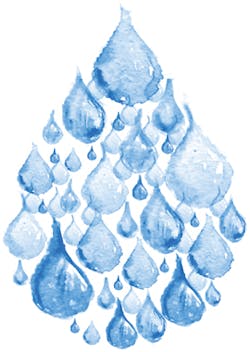Even as most of California and parts of Nevada, Oklahoma, Oregon, and Texas are still in a state of “exceptional” or “extreme” drought, there has been a bit of good news from the US Geological Survey. According to its latest survey, the US is using less water now than at any time during the last 45 years. In total we’re using about 355 billion gallons a day, down from 410 billion gallons in 2005.
Where are the savings coming from? It’s not only that we water consumers are more careful about how much we’re using-either through voluntary efforts or enforced rules about watering lawns and hosing down sidewalks-although that plays a part. Improved technologies such as higher-efficiency irrigation systems and better cooling systems for power plants also get much of the credit.
In light of the drought and the changing patterns of usage, it’s worth taking a look at how our profession has traditionally viewed water and how that might now be changing. ESC and stormwater professionals have often considered water something to get out of the way as harmlessly as possible-to prevent flooding; to keep high volumes of runoff from eroding streambanks, roadways, and active con-
struction sites; and to prevent water from carrying sediment and other pollutants offsite. We have looked on water not so much as a resource but as a nuisance. It was once common to shunt stormwater out of the way quickly through a public conveyance system, perhaps to a water treatment plant or, in areas with separate sewer systems, to the nearest lake, river, or ocean. More recently green infrastructure and low-impact-development efforts-again, some voluntary and some, especially for new federal facilities, mandated-are being used to retain water onsite.
Even with onsite retention, though, the goal from the ESC and stormwater perspective is still largely to get rid of the water, this time by infiltrating it. Using it for some other purpose is still, in many places, only an afterthought. Part of the reason is cost-installing the equipment to capture and redistribute water on a large scale is expensive, and water, for all its growing scarcity, is still relatively cheap, so it’s often not worth the investment for property and business owners. Homeowners on individual lots, with rain barrels and small-scale cisterns, have been somewhat more successful in capturing water to use for landscape irrigation, but this accounts for a relatively small percentage of the total reduction in potable water use.
Over the last couple of months, a petition has been circulating online-chances are you’ve seen it-asking the White House to support rainwater harvesting. Sponsored by the American Rainwater Catchment Systems Association, the petition reads in part, “We petition the Obama Administration to stimulate the emerging rainwater-harvesting industry through legislation or executive order, creating new jobs in design, installation, education, R&D, sales, plumbing, landscaping, roofing, monitoring and maintenance. . . .”
The many justifications include:
- Worldwide demand for clean water exceeds supply.
- Rainwater can help fill the gap and reduce stormwater pollution.
- One inch of rain is over 600 gallons per 1,000 sq. ft. of roof.
- Rainwater is a valuable resource that reduces demand on water infrastructure.
- A new national standard, ARCSA/ASPE/ANSI 63, details safe design & installation.
- Treated rainwater can easily surpass EPA standards.
What steps toward rainwater harvesting and use, if any, have you seen in your area? Particularly for those of you involved in landscape design and revegetation efforts, how practical and economical do you think it will it be to make use of captured stormwater on a large scale?
About the Author
Janice Kaspersen
Janice Kaspersen is the former editor of Erosion Control and Stormwater magazines.


